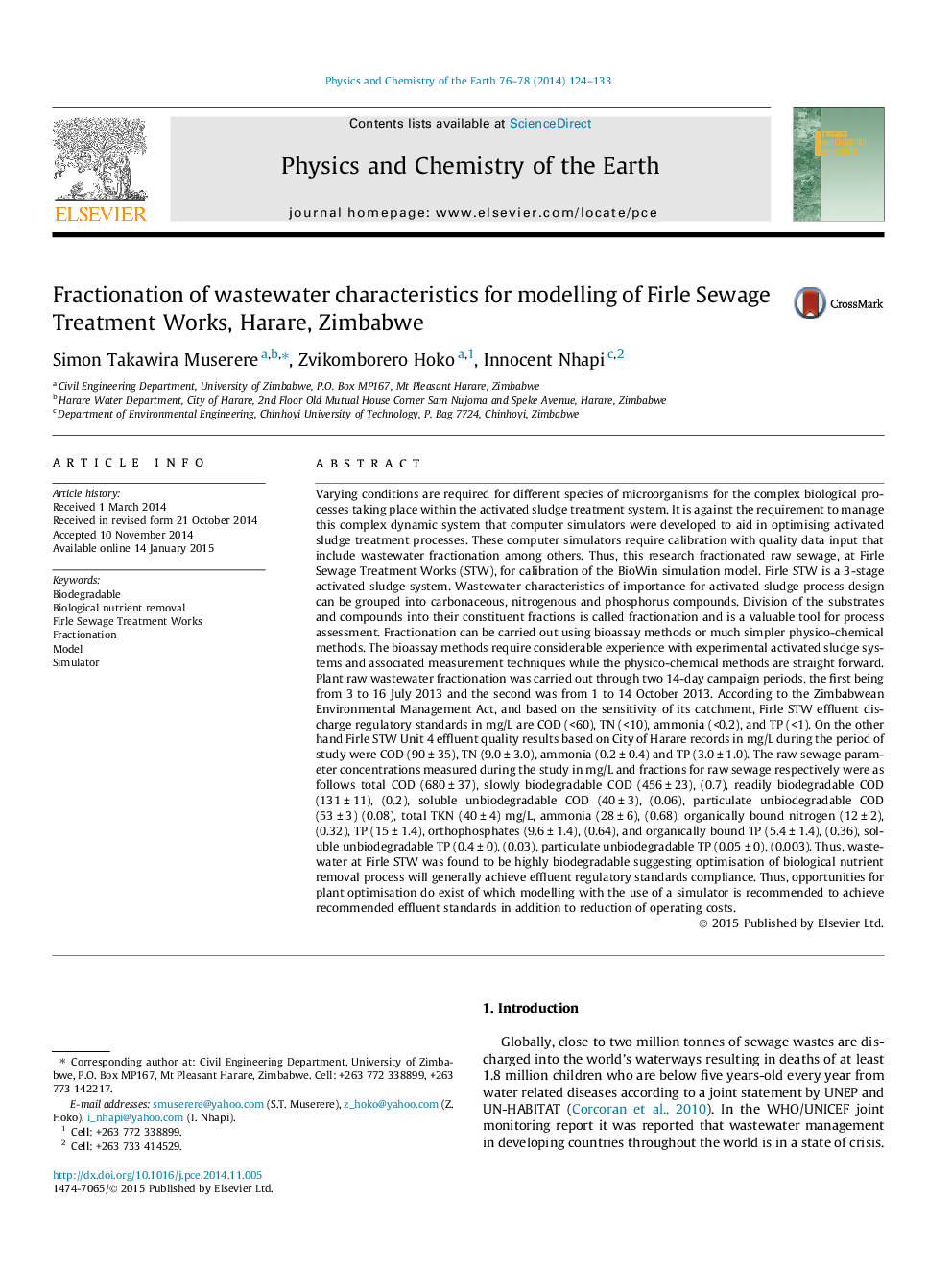| کد مقاله | کد نشریه | سال انتشار | مقاله انگلیسی | نسخه تمام متن |
|---|---|---|---|---|
| 4720969 | 1639353 | 2014 | 10 صفحه PDF | دانلود رایگان |

• We fractionate domestic with industrial contribution raw sewage.
• Fractionation information will aid in plant optimisation.
• Nutrient removal is dependent on readily biodegradable COD.
• The calibrated simulator is meant to optimise nutrient removal.
Varying conditions are required for different species of microorganisms for the complex biological processes taking place within the activated sludge treatment system. It is against the requirement to manage this complex dynamic system that computer simulators were developed to aid in optimising activated sludge treatment processes. These computer simulators require calibration with quality data input that include wastewater fractionation among others. Thus, this research fractionated raw sewage, at Firle Sewage Treatment Works (STW), for calibration of the BioWin simulation model. Firle STW is a 3-stage activated sludge system. Wastewater characteristics of importance for activated sludge process design can be grouped into carbonaceous, nitrogenous and phosphorus compounds. Division of the substrates and compounds into their constituent fractions is called fractionation and is a valuable tool for process assessment. Fractionation can be carried out using bioassay methods or much simpler physico-chemical methods. The bioassay methods require considerable experience with experimental activated sludge systems and associated measurement techniques while the physico-chemical methods are straight forward. Plant raw wastewater fractionation was carried out through two 14-day campaign periods, the first being from 3 to 16 July 2013 and the second was from 1 to 14 October 2013. According to the Zimbabwean Environmental Management Act, and based on the sensitivity of its catchment, Firle STW effluent discharge regulatory standards in mg/L are COD (<60), TN (<10), ammonia (<0.2), and TP (<1). On the other hand Firle STW Unit 4 effluent quality results based on City of Harare records in mg/L during the period of study were COD (90 ± 35), TN (9.0 ± 3.0), ammonia (0.2 ± 0.4) and TP (3.0 ± 1.0). The raw sewage parameter concentrations measured during the study in mg/L and fractions for raw sewage respectively were as follows total COD (680 ± 37), slowly biodegradable COD (456 ± 23), (0.7), readily biodegradable COD (131 ± 11), (0.2), soluble unbiodegradable COD (40 ± 3), (0.06), particulate unbiodegradable COD (53 ± 3) (0.08), total TKN (40 ± 4) mg/L, ammonia (28 ± 6), (0.68), organically bound nitrogen (12 ± 2), (0.32), TP (15 ± 1.4), orthophosphates (9.6 ± 1.4), (0.64), and organically bound TP (5.4 ± 1.4), (0.36), soluble unbiodegradable TP (0.4 ± 0), (0.03), particulate unbiodegradable TP (0.05 ± 0), (0.003). Thus, wastewater at Firle STW was found to be highly biodegradable suggesting optimisation of biological nutrient removal process will generally achieve effluent regulatory standards compliance. Thus, opportunities for plant optimisation do exist of which modelling with the use of a simulator is recommended to achieve recommended effluent standards in addition to reduction of operating costs.
Journal: Physics and Chemistry of the Earth, Parts A/B/C - Volumes 76–78, 2014, Pages 124–133